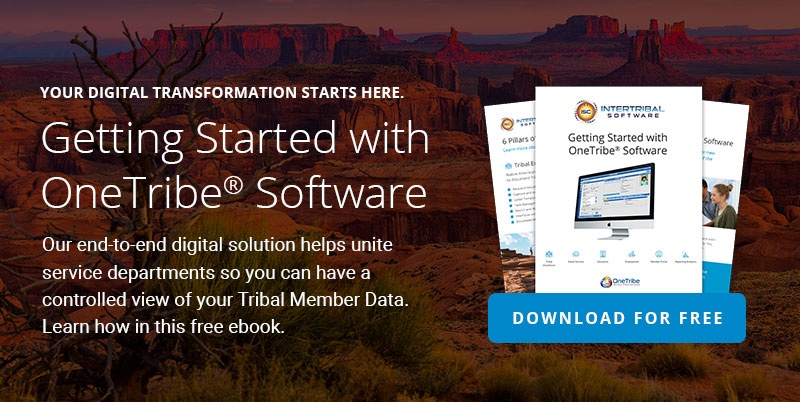
According to PTC, 70% of organizations have a digital transformation strategy or are working on one. With this rapid digitization, it’s no surprise the benefits from technology have become necessary to succeed and thrive in business. This is especially true with the need for quick, efficient transactions and operations.
Tribal organizations are at an optimal point to reap the rewards from a digital transformation strategy. While many try or are in the process of doing so, not every tribal government experiences the same levels of success since they’re not being mindful of everything that goes into digital transformation.
Here are some tips on how you can build a sustained, valuable digital transformation strategy that implements well over time – not just initially.
What is Digital Transformation?
In essence, digital transformation is a broad business plan that involves using technology to improve outcomes and revenue. As a tribal leader, you’re tasked with a multitude of obligations and moving parts – from payroll to compliance to healthcare records – and digitizing these can feel overwhelming. With the proper strategy in place, you’re empowered to build your digital solutions in a customizable, scalable way that grows with your tribe.
The common issue with digital transformation is organizations try to do too much at once, and experience problems following through consistently to ensure the implementation goes smoothly. With a plan in place, you’ll be able to effectively prioritize what needs to be done first and make necessary changes over the long haul. It’s much like building the foundation of a house first – starting with the base materials and adding on once the foundation is established.
Building Your Tribe’s Digital Transformation Strategy
You’ll need different kinds of technology building blocks in order to assemble your strategy, including, but not limited to:
- Robotics and automation
- The Internet of Things (IoT)
- Digital devices
- Cloud hosting
- Data analytics
Think of these next operational steps as the next development – how you’ll use the foundational elements and technology above to assemble a long-term strategy:
- Gain buy-in with your tribal organization: Knowing your processes is a step toward improving them, and your people are at the heart of how things are run. At its roots, technology won’t work without the people using it being willing to learn and onboard. Communicating the business value of digital transformation technology, such as easing the burden of paperwork or volume of requests that come in, will give you talking points that will gain everyone’s attention and get them invested in the process.
- Identify your tribe’s immediate priorities, needs, and challenges: Once you’ve got everyone’s buy-in, take time to gather feedback around your biggest hurdles. Where are things getting bottlenecked? What will initially make the most impact? It doesn’t always have to be the largest step – in fact, small changes can have huge rewards over time, especially when it comes to automation. This drives accelerated time to value, which is low-hanging fruit that will boost usability.
- Create a long-term technology implementation roadmap: Sure, there are steps leading up to an initial launch of your technology solution, but it shouldn’t stop there. Making regular updates on software and tweaks as processes change will be an essential piece of compounding ROI and long-term success with your digital transformation strategy. You’ll want to select technology that grows alongside your tribe, as this will be what drives adoption.
- Appoint a team for ongoing project management: While many work with technology experts to launch digital transformation, it’s still wise to have a point of contact. These internal ambassadors for the solution will work with technology partners and report on the success rate of the solution itself.
- Evaluate and iterate: Everyone’s digital transformation strategy blueprint – even from tribe to tribe – is going to vary. Part of ensuring its long-term revenue gains and effectiveness lies in the agility around changes. They’re inevitable, so be willing to adapt with it! You’ll find many of the updates will add value and contribute to a better user experience for tribal members when all is said and done.
Digital Transformation Happens in Phases
Much like a blueprint, your technology won’t ever be “finished.” Things are always updating, and that’s okay. Having a starting point to build, learn from your mistakes, and improve is where digital transformation’s value truly shines through. If you’re ready to pin down your own tribe’s digital transformation strategy through cloud-based software, feel free to contact us or subscribe to our blog to read more about our tribal software, built with tribal governments in mind.
Sign Up For Our Newsletter
Recent Posts
- Innovations in Housing: Revolutionizing Tribal Housing with Digital Tools for Management
- Empowering Tribal ICW Departments: Achieve ICWA Compliance and Certification Success with OneTribe® Software
- OneTribe CCA - Your Child Care Data Tracker Replacement Solution
- Transform Your Tribal Member Services With Integrated Software Solutions
- Intertribal Software Raises Strategic Investment
Categories
- OneTribe Software
- digital transformation
- tribal government software
- Laserfiche ECM
- Intertribal Software Consultants
- Childcare Assistance
- Housing Management
- Intertribal Software
- tribal member management
- AFCARS Data Collection
- Child Care Data Tracker
- Child Welfare
- Housing
- ICWA
- ICWA Compliance
- Indian Child Welfare Act
- OneTribe Platform
- Title IV-E Certification
- Tribal Data Tracker
- Tribal Family Services
- Tribal Housing
- Tribal ICWA Software

















